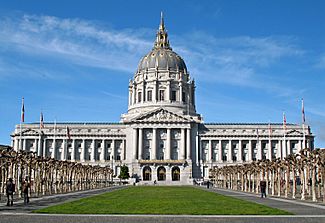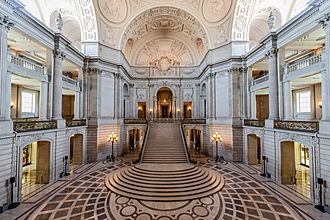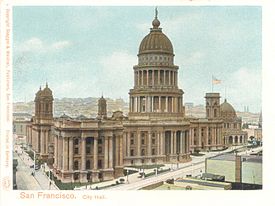San Francisco City Hall facts for kids
Quick facts for kids San Francisco City Hall |
|
|---|---|

(2008)
|
|
| General information | |
| Type | Government offices |
| Architectural style | Beaux-Arts |
| Location | 1 Dr. Carlton B. Goodlett Place San Francisco, California |
| Coordinates | 37°46′45″N 122°25′09″W / 37.77919°N 122.41914°W |
| Construction started | April 5, 1913 |
| Completed | July 28, 1916 |
| Cost | US$3.4 million ($98.4 million dollars in 2016) |
| Owner | City and County of San Francisco |
| Management | Real Estate Division |
| Height | |
| Antenna spire | 93.73 m (307.5 ft) |
| Technical details | |
| Floor count | 5, including ground floor |
| Floor area | >46,000 m2 (500,000 sq ft) |
| Lifts/elevators | 7 (6 passenger, 1 freight) |
| Design and construction | |
| Architect | Bakewell & Brown |
| Designated: | 1970 |
| Reference #: | 21 |
San Francisco City Hall is the main building for the government of San Francisco, California. It is located in the city's Civic Center area. This beautiful building, opened in 1915, is a great example of Beaux-Arts architecture. This style was popular during a time when cities wanted to look grand and beautiful.
The dome of San Francisco City Hall is even taller than the dome of the United States Capitol building in Washington D.C. The current City Hall replaced an older one that was destroyed in the big 1906 San Francisco earthquake. That earthquake caused a lot of damage in San Francisco.
The main architect for this building was Arthur Brown, Jr.. He paid close attention to every detail, even the doorknobs! Brown also designed other famous buildings in San Francisco, like the War Memorial Opera House and Coit Tower.
Contents
Exploring the Architecture of City Hall
San Francisco City Hall is a very large building. It covers two full city blocks and has more than 500,000 square feet (46,000 m2) of space. The building is 390 ft (120 m) long and 273 ft (83 m) wide.
The Grand Dome and Materials
The building's impressive dome rises 307.5 ft (93.7 m) high. It was inspired by famous domes in Paris, France. This dome is 19 ft (5.8 m) taller than the one on the United States Capitol. It is also 112 ft (34 m) wide. The dome rests on huge steel beams, some weighing 50 tons each!
The City Hall is built with strong materials. Its outside is covered with granite from Madera County. Inside, you'll find Indiana sandstone and beautiful marbles from Alabama, Colorado, Vermont, and Italy. Many statues inside were created by Henri Crenier.
Inside the Rotunda
The Rotunda is a spectacular open space right in the center of the building. You can go up to the upper levels, which are open to the public. The Mayor's office is on the second floor, across from the grand staircase.
You can see statues of past mayors near the Mayor's office. A bust of former county supervisor Harvey Milk was added in 2008.
An important message is carved into the Rotunda, below a figure of Father Time. It says:
SAN • FRANCISCO
O • GLORIOVS • CITY • OF • OVR
HEARTS • THAT • HAST • BEEN
TRIED • AND • NOT • FOVND
WANTING • GO • THOV • WITH
LIKE • SPIRIT • TO • MAKE
THE • FVTVRE • THINE
1912 JAMES ROLPH JR. MAYOR 1931
These words were written by a former Mayor, Edward Robeson Taylor. They were dedicated by Mayor James Rolph. The Rotunda also has medallions with words like Equality, Liberty, Strength, and Learning.
History of San Francisco City Hall
The City Hall we see today is not the first one. The original building was finished in 1899 after 27 years of work. It was a much larger building.
The 1906 Earthquake and Rebuilding
In 1905, a city planner named Daniel Burnham suggested a new design for the city, including a new Civic Center. But these plans were put on hold after the devastating 1906 San Francisco earthquake. The earthquake completely destroyed the 1899 City Hall.
After the earthquake, plans for rebuilding the Civic Center called for a neo-classical style. The city wanted to rebuild quickly, especially for the 1915 Panama–Pacific International Exposition. People voted to approve money for the new City Hall in 1912.
Construction began on April 5, 1913. The building was finished by 1915, just in time for the Exposition. Mayor Rolph moved into the new City Hall in December 1915. The last stone was placed in March 1916, and construction officially ended in July 1916.
Important Events at City Hall
The main Rotunda has been the site of many important events.
- In 1917, General Fredrick Funston, a hero from the Spanish-American War and the 1906 earthquake, was honored here.
- Former mayor and governor James Rolph was also honored here after his passing in 1934.
- Famous baseball player Joe DiMaggio and actress Marilyn Monroe were married at City Hall in January 1954.
- In May 1960, students protested a government committee in the Rotunda. This event was remembered during the Free Speech Movement at UC Berkeley a few years later.
- In 1978, Mayor George Moscone and Supervisor Harvey Milk tragically lost their lives at City Hall.
- The 1989 Loma Prieta earthquake caused damage to the building. The dome shifted four inches from its base.
Earthquake Safety Upgrades
After the 1989 earthquake, City Hall underwent major repairs to make it safe from future earthquakes. Engineers installed a special "base isolation" system. This system helps the building move with the ground during an earthquake, preventing it from collapsing.
City Hall reopened in January 1999 after these upgrades. At that time, it was the largest building in the world with this type of earthquake safety system.
Changes to Civic Center Plaza
The large open area outside City Hall, called Civic Center Plaza, has changed over the years. It used to have brick areas and simple fountains. Later, it was dug up to create underground parking. A rectangular pond and many trees were added.
In the 1990s, the plaza was remodeled again. The pond was replaced with a lawn. This change helped save energy and water.
Lighting Up the Night
Today, the outside of the Rotunda and the columns can be lit up with colorful LED lights. The colors change for different events happening in the city.
See also
 In Spanish: Ayuntamiento de San Francisco para niños
In Spanish: Ayuntamiento de San Francisco para niños





